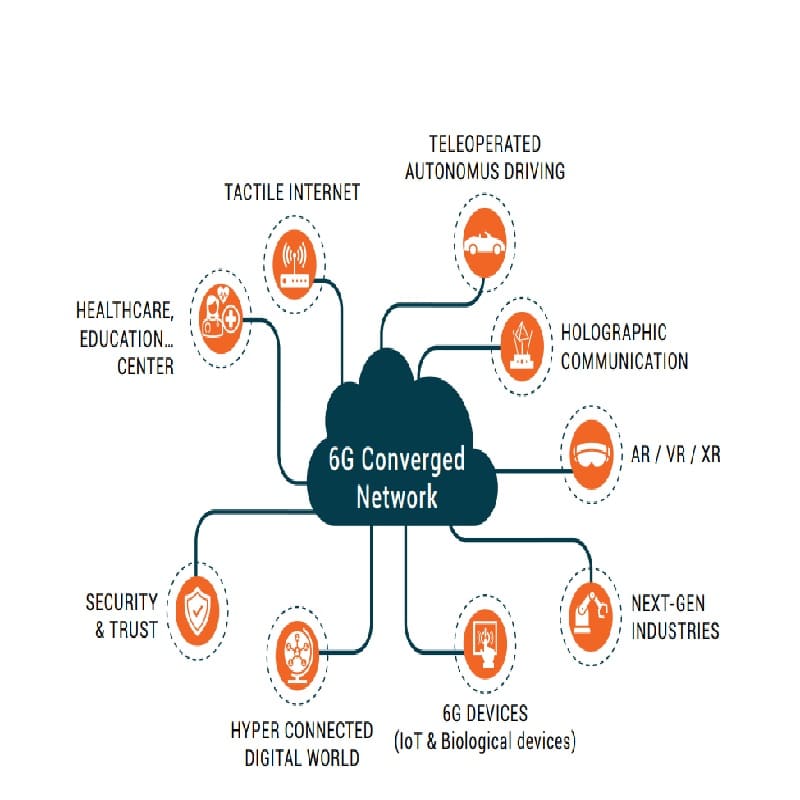
By 2030, India is preparing to launch high-speed 6G communication services and has initiated the Bharat 6G project to finance research and implementation of advanced technology in the country.
Currently, 6G does not exist as a tangible technology; instead, it has been conceptualized as a considerably more advanced option that promises internet speeds up to 100 times better than 5G.
Objectives of the Bharat 6G project
The objective is to establish India as a prominent worldwide provider of affordable 6G telecommunications intellectual property, products, and solutions, as well as to identify key areas for 6G research based on the country’s competitive strengths.
The apex council, appointed to oversee the project will place significant emphasis on emerging technologies, including Terahertz communication, radio interfaces, tactile internet, artificial intelligence for connected intelligence, novel encoding techniques, and waveforms chipsets for 6G devices.
The vision of Bharat 6G project
The Bharat 6G Mission is completely aligned with India’s national vision of Atmanirbhar Bharat and aims to empower every Indian to become self-reliant in their lives. Moreover, it endeavors to secure India’s rightful place in the world as a leading provider of affordable and advanced telecommunications technologies and solutions that contribute to the global good.

Implementation of the Project
The Bharat 6G project is set to unfold in two stages, the initial stage will span from 2023 to 2025, followed by the second stage from 2025 to 2030.
During the first phase, backing will be given to exploratory concepts, high-risk approaches, and proof-of-concept trials. Ideas and approaches that demonstrate potential for acceptance by the international peer community will receive sufficient support to see them through to completion.
In the second phase, they will establish their use cases and benefits, generate implementational intellectual property, and develop testbeds, ultimately leading to commercialization.
Pillars of 6G Vision
Six task forces formed under the Technology Innovations Group manage the 6 pillars of the Bharat 6G Project.
- Multi-Platform Next-Generation Network
- Ecosystem for devices and systems
- R&D Finance
- Standardization
- Innovative Solutions
- Identification of the Spectrum
Key Recommendations to Enable Bharat 6G Mission
The Task Forces’ key recommendations to pursue to enable the Bharat 6G Mission Project are provided below:
- Innovative funding mechanisms to support industry, startups, academia, and national laboratories to undertake R&D.
- Innovative solutions through startups that leverage the emerging 6G technologies to address key verticals such as transport, water, power grid and renewables, healthcare, education, digital twins, and smart cities.
- Shared use of spectrum, particularly in the higher frequency bands where the propagation is more akin to that of light.
- Participation and contribution to global standards forums to ensure interoperability and global reach of our innovation.
- Fiber-broadband to every home and integrated dense wireless and optical network, with wireless communications primarily serving mobile users.
- Space-Terrestrial Integration for ubiquitous coverage.
- Combined communication and sensing in (Sub-) Terahertz bands.
What is 6G?
6G is the sixth generation of wireless communication technology that is expected to succeed the current 5G technology. It is still in the conceptual stage and is being researched and developed by various companies and organizations around the world.
6G is expected to provide even faster internet speeds, lower latency, and more reliable connections than 5G. It is projected to enable new applications such as seamless virtual and augmented reality, ubiquitous sensing, and machine learning-based communication systems.
Additionally, Bharat 6G Project is expected to improve connectivity in remote and rural areas and provide solutions for various industries such as healthcare, transportation, and manufacturing.
Benefits of 6G Technology
The benefits of 6G technology are expected to be numerous, including:
- Faster Internet Speeds: 6G is projected to offer internet speeds of up to 1 terabyte per second, which is about 100 times faster than 5G.
- Lower Latency: 6G is expected to have ultra-low latency, meaning there will be a very little delay in data transmission. This will enable smooth interactions, especially for applications that require real-time response, such as autonomous vehicles and remote surgeries.
- Improved Connectivity: 6G is expected to provide more reliable and secure connectivity, especially in remote and rural areas where internet access is currently limited.
- New Applications: 6G is projected to enable new applications such as seamless virtual and augmented reality, ubiquitous sensing, and machine learning-based communication systems.
- Economic Development: 6G is expected to boost economic development by enabling innovation in various industries such as healthcare, transportation, and manufacturing. It may also slow down rural migration to cities and metro-led urbanization.
Possible Challenges Associated with 6G technology
Like any new technology, Bharat 6G project also comes with some possible challenges. A few important of them are:
- Technical Complexity: 6G technology is expected to be much more complex than its predecessor, with a large number of components and subsystems. This complexity could make the development and implementation of 6G more challenging.
- Infrastructure Deployment: To deliver on the promise of 6G, significant investments will be required in terms of infrastructure development. This could pose challenges in terms of financing, regulation, and deployment.
- Spectrum Allocation: The availability of spectrum is crucial for the development and deployment of 6G technology. However, the spectrum is a finite resource, and allocating sufficient spectrum for 6G could be a challenge, particularly given the demands of other emerging technologies.
- Security: As with any new technology, 6G is likely to face security challenges. The high speeds and large amounts of data transmitted over 6G networks could make them vulnerable to cyber-attacks. Ensuring the security of 6G networks will be crucial to their success.
- Standardization: Developing standards for 6G will be essential to ensure interoperability and compatibility across different networks and devices. However, the process of developing and agreeing on standards can be time-consuming and complex, and disagreements among stakeholders could delay the rollout of the 6G technology.
Other Countries Focusing on 6G Network
Several countries are focusing on developing the 6G network, including South Korea, Europe, and Japan.
South Korea has announced its 6G research and development plan, which involves an investment of Rs 1,200 crore until 2025. The country has established dedicated research centers that are working closely with the Korean Intellectual Property Office.
In Europe, the European 6G Vision has identified the key features of this network and is currently undertaking a research project called Hexa-X, which is expected to conclude this year.
In Japan, the Integrated Optical and Wireless Network (IOWN) Forum has released its Vision 2030 white paper for 6G, outlining the key technology directions for infrastructure evolution in four dimensions: cognitive capacity, responsiveness, scalability, and energy efficiency.
Conclusion
The implementation of 6G technology in India under the Bharat 6G project is expected to bridge the gap in e-service provision for both urban and rural populations, leading to the achievement of the UN’s SDGs and significantly improving the quality of life. The introduction of innovative technologies tailored to India’s unique needs will enhance productivity, particularly for those in rural areas, who rely on telecommunications to overcome geographical barriers. Moreover, this technology will provide opportunities for Indian entrepreneurs to develop new products and intellectual property, making India a global leader in life-changing solutions for the world market.
Read: Digital Twin Technology
Article Written By: Priti Raj






Leave a Reply